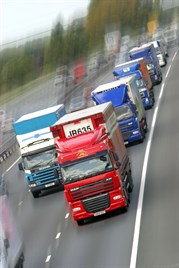
Read the peer reviews for this feature.
Download the graphs for this feature.
Recent research carried out for the Campaign for Better Transport’s Metropolitan Transport Research Unit (Heavy Goods Vehicles - do they pay for the damage they cause? June 2014) used existing Government criteria, and found that HGVs pay less than half of the costs associated with their activities in terms of road congestion, road collisions, road damage and pollution.
These are known as external costs - those costs that HGVs impose on others that are not included (internalised) in their normal operating costs.
Although the financial framework for rail and road is different, it is generally accepted that in both cases, revenues from moving people (in fuel duty, vehicle excise duty and fares) are to some extent used to support the movement of goods.
This report shows the level of distortion of the market across different modes. It suggests that the Government should adopt a holistic approach, treating all modes equally and delivering its policy on a balanced playing field, recognising the value equation between freight subsidy and the direct and indirect benefits to the UK economy. And it demonstrates that for as long as road continues to be so heavily subsidised, it will be very difficult for rail to compete - even though rail use reduces road congestion, is safer and less polluting.
The report also shows that HGVs do not meet their costs by some large margin, using different accepted assumptions. In fact, the report shows that HGVs pay less than 40% of costs imposed on society (an underpayment of about £5 billion a year, using Government assumptions), making a strong argument for sustainable modes being given more support.
The ideal option in terms of economic theory would be to charge road users for their marginal external costs (MECs), such as congestion, environment, climate change, accidents and infrastructure costs. External HGV costs are understood to be high in relation to operator running costs and other vehicle-type externalities. And importantly, rail could replace road on many flows with substantially lower marginal externalities.
The report explores the different approaches that can be used, focusing on what HGV costs are (using existing values from European and UK research) and to what extent taxes and charges cover these costs to assess if HGVs “pay their way”.
It reviews the current status and what might be done in the future, highlighting the benefits of distance-based lorry road user charging, and citing European examples. It evaluates the different accepted Government methods, marginal external cost and fully allocated cost model, and assesses the scale of undercharging using different economic assumptions (see Different costing methods panel, page 41).
The research ultimately highlights that the Government needs to be transparent, so that the level of subsidy is acknowledged and mechanisms can be used to correct these distortions. And the scale of subsidy to road makes a compelling case for supporting sustainable freight modes that impose much lower costs on society and the economy alike.
Government’s mode shift grant values are used to calculate the costs and are designed to recognise the wider advantages of water and rail, but currently support less than 15% of rail traffic, for example.
Mode shift benefit
The Mode Shift Benefit (MSB, page 40) is the most recent DfT estimate of average marginal external costs per mile for all articulated HGVs. The average marginal external cost is 83.9 pence per mile in 2010 prices, although there are wide variations on different road types. The tax income from VED and fuel duty is 34p per mile .
However, there are reasons to believe that the current report highlights a number of areas where the Government’s understanding of the costs and impact of lorries is flawed or outdated and that it demonstrates that the current MSB figures need to be revised to better represent the true costs. These include:
- Infrastructure costs: Infrastructure costs from HGVs are falsely low because capital costs of infrastructure are not included. Congestion costs might be disputed, but the capital cost of road building cannot be disclaimed.
Road damage from the heaviest lorries is estimated to be 150,000 times higher than for a typical car, therefore some of the heaviest road repair costs are almost exclusively attributable to the heaviest vehicles.
The largest and heaviest HGVs have the highest marginal costs - for example, six-axle articulated HGVs are 2.6 times more damaging than four-axle articulated HGVs. Thus the increase in the proportion of the largest vehicles means an overall increase in damage caused. In the UK, HGVs are hugely concentrated around the maximum limit, which is more damaging for road surfaces (see graph, page 40).
It can be argued that fuel duty does cover maintenance costs on motorways and A-roads, but not capital road costs on any road types. However, on local roads that are not built to the same specification as trunk roads, and are therefore less able to cope with HGVs, neither maintenance nor capital costs are covered.
The DfT mode shift benefit values (MSB, see table page 40) for the different road types highlight this. The costs per mile given for motorways is 4.7p, and for A-roads 10.8p, while all other roads are costed at 68.7p.











